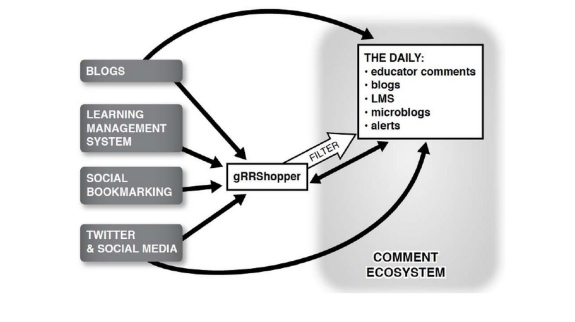Much of the mainstream media attention paid to MOOCs lately has involved the content, the credentialing, the cost, the class size. But what about the technology?
It was (not surprisingly) Stephen Downes’ OLDaily that got me thinking about what can we glean about MOOCs based on their infrastructure. Last week, Downes’ OLDaily highlighted a post from Dirk Uys, a member of the P2PU tech team, that describes the code that runs Peer 2 Peer University. For his part, Downes noted the differences between that code, Lernanta (source code), and his own gRSShopper (source code).
Django-based Lernanta is a fork of the code that ran Mozilla Drumbeat, once Mozilla’s community, communication, and project management software. Lernanta contains the features of many learning management platforms: user profiles, courses, schools, certification (or at least, badges). But as its origins in Drumbeat might suggest, Lernanta facilitates community management –how people participate, what people and projects they follow.
gRSShopper, on the other hand, is a piece of the ur-MOOC infrastructure (language really fails here) – that is, MOOCs as formulated and offered by Downes, Siemens, Cormier, Couros, et al. And to clarify again, if you’ve subscribed to the newsletters associated with these MOOCS – with LAK12, Change11, OLDaily, and the like – then you’ve received an email “generated by gRSShopper.”
gRSShopper, as Downes describes it, “is a personal web environment that combines resource aggregation, a personal dataspace, and personal publishing. It allows you to organize your online content any way you want to, to import content – your own or others’ – from remote sites, to remix and repurpose it, and to distribute it as RSS, web pages, JSON data, or RSS feeds.”
Rather than driving users to a course website or a learning platform for all their interactions, the users on gRSShopper “are assumed to be outside the system for the most part,” writes Downes, “inhabiting their own spaces, and not mine.”
Slide from George Siemens, “What is the Theory that Underpins Our MOOCs?”
That theory underpins gRSShopper.
But I don’t want to make too much of the difference between the learner-focused gRSShopper and the community-oriented Lernanta. Sure, there is plenty of difference, but I don’t think Lernanta is quite as demonstrative of P2PU theory as gRSShopper is for connectivism. And too, both these are both open source systems serving OER communities.
There’s another gulf again between these two systems and the new Stanford-model-MOOCs. (Although MITx – and now presumably edX – does say it will open source its MOOC platform (source code link?).) The latter MOOCs have recreated a traditional LMS in many ways for their technology platforms, driving (almost) all course activity onto their own course sites. Udacity does host its videos on YouTube. Otherwise, there’s no RSS. There’s no integration with external student blogs. The social or peer element involves primarily class forums. All work is done on and submitted via the platform.
That’s not to say, I suppose, that learners couldn’t take discussions elsewhere and adopt other tools – gRSShopper even – to do so. There’s been some of this in early community forums (again with the forums!) that grew out of the Stanford AI and Machine Learning classes, and I’m curious to see if learners will bubble out beyond the confines of the tech platform once Coursera offers more humanities and social science classes. Bookmarking, blogging, social media, RSS – will the new MOOCs open to these technologies?

[…] Read also: What Lies Beneath: Some Thoughts on MOOCs’ Tech Infrastructure […]